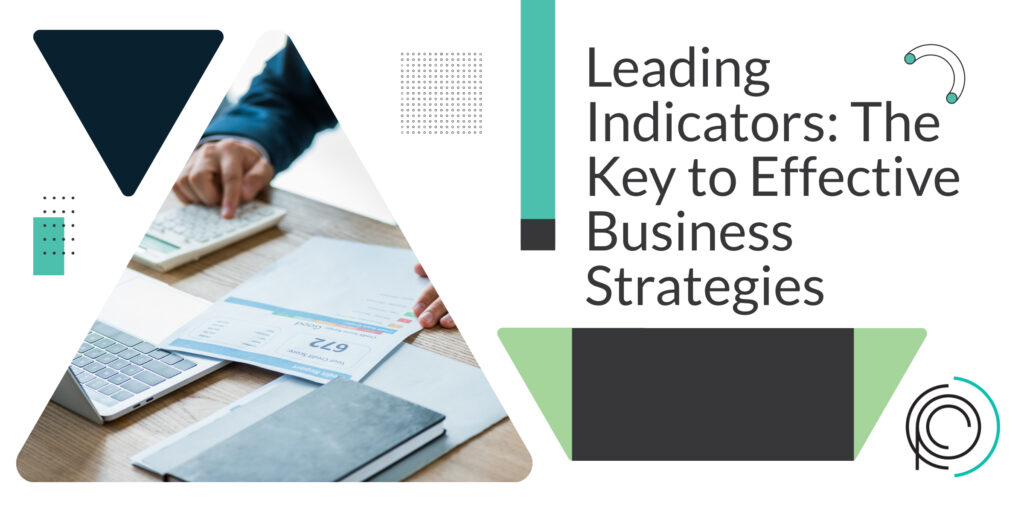Predict, Adapt, Thrive: The Power of Leading Indicators in Business Performance
As a business leader, you are aware that measuring performance metrics is a vital aspect of evaluating your company’s progress and effectiveness. However, traditional metrics like revenue, profit margins, and customer satisfaction scores only provide information after the fact. These lagging indicators cannot help you anticipate potential problems or opportunities in advance. This is where leading indicators come into play. In this post, we’ll discuss how leading indicators can help you make informed decisions that positively impact your bottom line.
Leading indicators
Leading indicators are invaluable predictive tools that play a crucial role in forecasting future trends, allowing businesses to make informed, proactive decisions. By staying one step ahead of potential challenges, companies can maintain a competitive edge in their respective markets. Unlike lagging indicators, which provide insights based on past performance, leading indicators offer the distinct advantage of foresight. This foresight is essential for companies aiming to address and mitigate issues before they escalate into significant problems. Through the strategic use of leading indicators, organizations can anticipate changes in the market, adjust their strategies accordingly, and navigate through uncertainties with greater confidence and efficiency.
Among the most frequently utilized leading indicators are metrics such as staff turnover rates, which can signal employee satisfaction; customer acquisition costs, which reflect the efficiency of marketing efforts; and marketing campaigns’ click-through rates, which gauge customer engagement. However, it’s important to recognize that not every leading indicator will hold the same weight or relevance across all industries. When selecting leading indicators to monitor, businesses must take into account the specific dynamics of their industry, the peculiarities of their organizational structure, and how these indicators align with the company’s strategic objectives.
One particularly impactful leading indicator is customer feedback. Actively listening to what customers have to say can provide businesses with the foresight to anticipate customer needs, assess their satisfaction levels, and thereby enhance customer retention rates. This can be achieved through a variety of methods, such as conducting detailed surveys to gather both qualitative and quantitative data, monitoring social media channels for real-time feedback, and organizing focus groups to dive deeper into customer preferences and experiences. These efforts not only furnish businesses with direct insights from their customer base but also facilitate the alignment of business strategies with customer desires, ensuring that companies remain responsive and adaptable in a competitive landscape.
Furthermore, integrating technology and data analytics into the process of tracking and interpreting leading indicators can significantly amplify their effectiveness. By leveraging sophisticated data analysis tools, businesses can sift through large volumes of data to identify patterns and trends that may not be immediately apparent. This approach not only enhances the precision of forecasts but also enables a more nuanced understanding of the factors driving those forecasts. As such, the judicious selection and analysis of leading indicators, underpinned by a thorough understanding of their implications, can serve as a cornerstone for informed decision-making and strategic planning in any business.
Employee engagement
Employee engagement stands out as a pivotal leading indicator of organizational health and effectiveness. Engaged employees, as highlighted in numerous studies including this one, are not just more productive; they bring a level of innovation and dedication to the company’s mission that can’t be matched by those who feel disconnected from their work. This heightened involvement and enthusiasm inevitably lead to a positive ripple effect across various aspects of business performance.
Measuring employee engagement can be achieved through several methods. Staff surveys, for instance, offer direct insights into how employees feel about their work environment and their role within the company. Retention rates provide another lens, revealing whether your workforce sees enough value in your organization to stay long-term. Similarly, absenteeism rates can serve as a telling indicator; excessive absences may signal low engagement levels.
Taking steps to improve employee engagement is not just a nice-to-have; it’s a strategic imperative. Enhanced engagement levels can lead to substantial benefits for your business. These include reduced staff turnover, which is not only a direct cost saver but also helps preserve organizational knowledge and culture. Additionally, a more engaged workforce can significantly enhance the customer experience, leading to higher satisfaction and loyalty. Ultimately, these improvements contribute to increased profitability, demonstrating the far-reaching impact of employee engagement on your business’s success.
Sales forecasting
Sales forecasting stands out as a crucial leading indicator empowering businesses to predict future revenue trends and refine their sales strategies for optimal performance. Through a meticulous analysis of past sales data, seasonal patterns, fluctuations in market demand, and various other determinants, companies are equipped to project their future sales with a higher degree of accuracy. This foresight allows for the strategic allocation of resources and budget adjustments to ensure that operations are streamlined and efficient.
Moreover, sales forecasting isn’t just about predicting numbers; it’s a strategic tool that assists businesses in identifying potential areas for growth and expansion. By understanding market dynamics and consumer behavior, companies can spot opportunities they might otherwise overlook. Additionally, it plays a vital role in risk management. By anticipating downturns or shifts in market demand, businesses can devise contingency plans, thus minimizing the impact of unforeseen challenges.
In essence, the art of sales forecasting is indispensable for businesses aiming to maintain a competitive edge. It offers a clearer vision of the future, enabling decision-makers to craft strategies that not only meet the current market conditions but are also adaptable to future changes.
Social Media
Social media analytics stand out as a potent leading indicator, offering the ability to monitor the success of your marketing strategies in real time with unparalleled precision. By delving deep into social media metrics, including reach, engagement, and conversion rates, marketers can quantitatively measure the return on investment (ROI) of their efforts. This enables the strategic adjustment of marketing campaigns to enhance their effectiveness and achieve targeted outcomes.
Furthermore, social media analytics extend beyond mere numbers. They unravel valuable insights into customer sentiment, allowing businesses to understand how their brand is perceived online. This can lead to more empathetic and customer-focused marketing strategies. Additionally, by keeping an eye on market trends, companies can anticipate changes in consumer behavior and adapt swiftly, staying ahead of the curve. Analyzing competitors’ activities through social media analytics also provides a clear view of their strengths and weaknesses, offering opportunities to differentiate and capture market share.
In essence, social media analytics act as a compass in the vast ocean of digital marketing, guiding businesses toward more informed decisions, more engaging content strategies, and ultimately, more successful outcomes.
Leading indicators serve as a valuable tool for businesses, offering predictive insights into future market trends and enabling them to make proactive decisions crucial for long-term success. These indicators, when meticulously analyzed and implemented, can illuminate the path forward, allowing companies to adjust their strategies in real time and maintain a competitive edge in their respective industries.
The four leading indicators mentioned – customer feedback, employee engagement, sales forecasting, and social media analytics – each plays a pivotal role in a business’s ability to foresee and adapt to changes. Customer feedback, for instance, offers direct insights into what consumers desire and their satisfaction levels, guiding product development and customer service improvements. Employee engagement measures the commitment and morale of a company’s workforce, which directly impacts productivity and, ultimately, profitability. Sales forecasting helps businesses anticipate demand, manage inventory more efficiently, and allocate resources effectively. Lastly, social media analytics provide a real-time snapshot of market trends and public perception, enabling companies to craft targeted marketing strategies and engage with their audience more effectively.
Incorporating these leading indicators into a company’s strategic planning process can significantly enhance its ability to anticipate potential challenges and seize new opportunities as they arise. This proactive approach can be the difference between a company that merely reacts to market changes and one that thrives by staying ahead of them.
Effective implementation of leading indicators is not just a matter of tracking metrics; it demands a strategic mindset coupled with a firm commitment to continuous improvement. By proactively measuring and analyzing these indicators, company leaders can significantly refine their decision-making processes. This approach leads to a more agile, responsive, and, as a result, more successful organization. In the context of a rapidly changing business landscape, the ability to leverage leading indicators for strategic advantage is invaluable. It empowers companies to not only survive the tumultuous markets but to thrive, ensuring their long-term growth and sustainability.
Moreover, there are numerous tools available in the market specifically designed to assist businesses in effectively measuring and monitoring these leading indicators. These tools range from sophisticated analytics platforms to more straightforward dashboard applications, all aimed at providing actionable insights. By utilizing these tools, businesses can gain a clearer understanding of their current position and forecast future trends with greater accuracy. This, in turn, enables them to make informed decisions, optimize their strategies, and stay ahead of the competition.
Still have questions? Click here to schedule a session with one of our seasoned experts. They offer personalized guidance to help you pinpoint and track the leading indicators in your business, ensuring you stay ahead in your industry.






